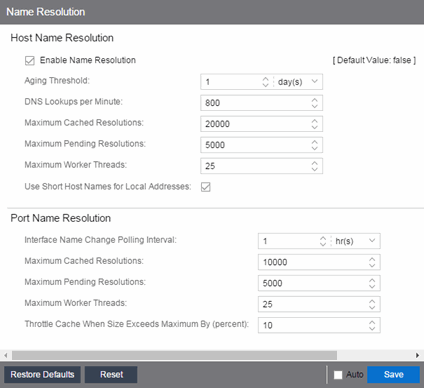Selecting Name Resolution in the left panel of the Options tab displays the following view, where you can configure options related to host name and port name resolution.
Changing a value from the system default causes a Default Value button to appear. Selecting this button changes the field back to the system default value.

Host Name Resolution
Use this section to set options for resolving host names to IP addresses and IP addresses to host names.
- Enable Name Resolution
- Select this option display host names in place of IP addresses throughout ExtremeCloud IQ Site Engine. This feature is primarily used by NetFlow. With name resolution enabled, flow data shows "Client=rsmith-ws Server=proxy-usa", rather than "client=10.20.0.2 server = 10.20.0.1". The option is off by default because name resolution can add additional load on the network’s DNS server.
- Aging Threshold
- Use this option to determine how long IP/host name pairs are cached in memory. After the aging threshold time has passed, the IP/host name pair is removed from the cache in order to prevent stale IP/host name associations. This option addresses the fact that DHCP assigns a new IP address to users frequently, especially on reboots. Without an aging threshold, host names continue to be associated to the IP they had at the first lookup. The default value is 24 hours; the minimum value is 1 hour.
- DNS Lookups per Minute
- The maximum number of host name lookups that the DNS server can perform each minute. This prevents host name resolution from using so many resources on a switch, which can affect switching of real traffic.
- Maximum Cached Resolutions
- The maximum number of IP/host name pairs that can be cached in memory. This number can be adjusted to control the amount of memory used by this service.
- Maximum Pending Resolutions
- The maximum number of host name resolution requests that can be queued up. This number can be adjusted to control the maximum amount of time spent waiting for a resolution.
- Maximum Worker Threads
- The maximum number of host name lookups that can be done at the same time. This number can be adjusted to control the amount of system resources used by host name resolution.
- Use Short Host Names for Local Addresses
- This option is enabled by default when host name resolution is enabled. When enabled, the host name cache removes the fully qualified host name's domain if it matches one of the specified local address domains. For example, "jsmith-ws.mycompany.com" displays as "jsmith-ws" if mycompany.com is listed as a local address domain. Disable this option when troubleshooting problems with host name resolution, or if IP addresses are preferred.
Port Name Resolution
Use this section to set options for resolving device port indices to port names and port aliases, and device port names and port aliases to port indices.
- Interface Name Change Polling Interval
- This option specifies how often the port name resolution service checks devices to see if port information has changed.
- Maximum Cached Resolutions
- The maximum amount of port data that can be cached in memory. This number can be adjusted to control the amount of memory used by this service.
- Maximum Pending Resolutions
- The maximum number of port name resolution requests that can be queued up. This number can be adjusted to control the maximum amount of time spent waiting for a resolution.
- Maximum Worker Threads
- The maximum number of port name lookups that can be done at the same time. This number can be adjusted to control the amount of system resources used by port name resolution.
- Throttle Cache When Size Exceeds Maximum By (percent)
- This option controls how much port data is discarded from the cache when its size is exceeded. Adjust this to control how an overfull cache is reduced.
For information on related help topics: